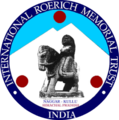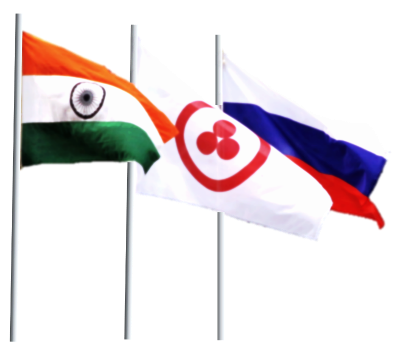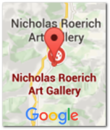24.05.2024
Exhibition of Gujarat artists at IRMT
On 24 May, the International Roerich Memorial Trust inaugurated an exhibition of artists from Vadodara, Gujarat. Among the attendees at the opening ceremony were Mrs Larisa Surgina, Russian Curator of the IRMT and an employee of the International Centre of the Roerichs (Moscow), Mr. Suresh Kumar, Indian Curator of the IRMT, and other distinguished guests. All attendees participated in an interactive and informative tour of the exhibition.
The state of Gujarat is situated in the west of India and is renowned for its affluent and multifaceted culture, encompassing a plethora of ornate adornments, traditions that diverge from those observed elsewhere on the Indian mainland, the originality of its rituals, folk crafts and ethnic diversity. Several of their paintings are still in the museum's collection today. The rich traditions of the state are reflected in the works of the artists presented at the exhibition. A total of 15 artists working in different genres and techniques took part in the exhibition.
It is not coincidental that Kirit Patel has advocated for harmonious coexistence with the natural environment for the benefit of humanity's future. He has implemented numerous humanitarian projects to improve the environmental situation in his home state of Gujarat and beyond. He is convinced that attention to the environment will foster awareness of the necessity for peaceful coexistence. Nicholas Roerich was guided in his life by the motto "Peace through Culture". For Kirit Patel, his life's motto is "Peace through Environmental Protection". However, it can be said that Roerich's ideas and Mr Patel's ideas are similar in many ways. Kirit Patel is of the conviction that the dissemination of truth, regardless of the source or the means employed, and the pursuit of goodness for humanity, will ultimately yield the greatest benefit for all if it is driven by a genuine desire from the heart.
The inauguration of the exhibition commenced with the customary lamp-lighting ceremony, Deep Prajavalam, during which the artists themselves and the attendees of the exhibition participated. In Indian tradition, fire is a symbol of purification, concentration, and solemnity. The lamp-lighting ceremony, which typically occurs at the outset of cultural events, is designed to establish a conducive atmosphere for participants and spectators alike, enhance perceptual accuracy, and convey gratitude for the opportunity to realise the planned work. Foreign guests, artists and curators of the IRMT lit the sacred fire together, as if to illustrate the words of the exhibition's guest of honour, economist and philanthropist Kirit Patel, who began the tour of the exhibition: "When we talk about the planet, about resources, about what it is made of, we often forget the most important component - humanity. We forget that we are one with this planet, that we toil, work, create - in an attempt to find harmony, to become happy. Our creativity, our oneness, is what brings joy, through suffering, through trials. We, as a group of creators, must see the oneness of everything - in the nature around us, in the butterflies fluttering around us, in every visible and invisible element of this world - for the good of humanity, for the sake of achieving happiness in harmonious coexistence with each other".
It is of interest to note that the town of Vadodara (formerly known as Baroda) is associated with the names of the Roerichs. In the 1940s, exhibitions of Nicholas Roerich and Svetoslav Roerich were hosted by the Baroda Art Gallery on several occasions, thanks to the personal interest of His Highness the Maharaja.
The tour of the exhibition commenced with a presentation by Atul Padia, the artist and curator of the exhibition. Mr. Padia proceeded to showcase his own works. The exhibition presents a series of paintings by the author, which are dedicated to the theme of dialogue. The images depicted in the paintings are presented in a state of contradiction and disharmony. However, despite this dissonance, the images are represented as if in the form of communicating vessels. The paintings offer an interpretation of the complexity of interactions between individuals of different generations. While they may appear to be unable to understand each other, the expressions on their faces suggest surprise, anger, and a sense of disconnection. However, the figures are also connected, forming one unified whole, a line of continuity. The paintings illustrate the concept of mutual comprehension despite apparent discrepancies and impediments. The artist employs three distinct techniques in the execution of her works: painting, drawing, and digital painting.
The works of artist Mala Yagnesh Shukla presented in the exhibition can be considered a visual narrative of forgiveness and unity. This narrative is conveyed through the acceptance and understanding that transcends misunderstanding. The paintings, executed in contrasting colours, convey the drama of the challenging process of reconciliation and the transition from the conflict of misunderstanding to the harmony of forgiveness. Vijay Kachhia is a school art teacher who is proficient in a range of traditional painting techniques. However, in his own work, he eschews imitation of reality and instead employs abstraction. The works of Sanjivani Chaudhary are presented in a variety of techniques and styles, including sketches of traditional portraits, a series devoted to bird and plant images, photography, and finally, computerised paintings depicting dancers in motion. The watercolours of Minakshi Patel are characterised by an inner radiance and tenderness, conveying a sense of joy and life affirmation. Despite having overcome a serious illness, namely cancer, the artist has not lost her vivacity or inner joy, which are transmitted to the viewer upon getting acquainted with her works. The artist's works demonstrate the triumph of the spirit over matter. Sonal Odedara employs a diverse range of techniques and utilises a variety of materials in her artistic practice. The exhibition includes several works created on the leaves of the pipal tree, which is sacred to India. Additionally, it features photographic paintings and the artist's reflections on texts, which have developed into a series of abstract works. Suryakanta Goswami's photographic works depict the cultural specificity of the eastern region of Gujarat on the border with Maharashtra, specifically the Satpura range in the northern part of the Deccan. The photographs display a variety of masks and terracotta figurines, which are used during ceremonies and traditional rituals. Pallavi Variya's work continues the theme of the traditional culture of the state. Gujarat is renowned for its diverse array of embroidery techniques, which are typically executed on hand-dyed and sun-dried fabric. The tradition of Gujarat embroidery has a history spanning several centuries. The artist's work pays homage to these rich traditions, while also incorporating elements of contemporary art. We observe the coexistence of living traditions imbued with new, contemporary meanings. The photographic works of Manish Joshi and Bibal Mehta offer a kaleidoscopic portrayal of the lives of ordinary people in various locations across India and surrounding territories, from Kathmandu to Benares to Hyderabad. These images reflect the rich and diverse cultural tapestry of the country. Nandubhai Rathwa is a member of one of the numerous tribes that inhabit the state of Gujarat. The western and north-western states of India, including Rajasthan, Gujarat and parts of Madhya Pradesh, are home to numerous small Adivasi tribes whose traditions and cultures differ significantly from those of neighbouring regions. In his artistic output, Nandubhai Rathwa, a professor at the Faculty of Fine Arts, Baroda University, endeavours to convey the distinctive character of his native culture through a personal interpretation. This is achieved through sketches and portraits of Adivasi people, depictions of traditional dances, and figurative representations of cultural elements that are significant to the artist. The author's narratives about the cultural heritage of his people elicited a resounding response from the audience. Many attendees recalled personal experiences of interacting with the Adivasi people of Gujarat, which had touched them profoundly. Representatives of tribal cultures typically reside in conditions of relative poverty, constrained by natural conditions such as desert and arid climates, high temperatures, and scorching sun. Despite the harshness of life, they are known for their hospitality and willingness to assist travelers in difficult situations, sharing leftover food and water. Gujarat-based artist Parmendra Gajjar (Param) has paid tribute to Himachal's rich culture with an exhibition of several of the artist's works on the traditional architecture of the state. The works are executed on the bark of Himalayan birch trees. It has been established that the northern regions of India have been utilising birch bark as a medium for painting and writing since ancient times, in a manner similar to the Slavs. Bhavna Patel's works are notable for their traditional technique, "lippan kaam," which involves inlaying clay surfaces with mirrors. This technique is characteristic of the Kutch region of Gujarat. The paintings of artist and poet Avani Shah depict awe-inspiring vistas of the celestial realm. All of the artist's works are dedicated to higher powers and the higher world, and are inspired by images that appear in the author's mind during meditation. Virendra Kumar's works continue the theme of spirituality, presenting sunny views of Mount Kailas, a sacred site for Hindus and Buddhists, imbued with an inner harmony.
The exhibition of Vadodara artists reflects the diversity and richness of Gujarat's culture. It is notable that many artists work in completely different techniques, which introduces the viewer to a modern interpretation of the state's traditional cultural values. Elements and styles that may appear incongruous are combined in a single room, yet at the centre of this arrangement is the unity and value of culture.























